 Ms. Marvel #1 — Writer: G. Willow Wilson; Art: Takeshi Miyazawa and Adrian Alphona; Colors: Ian Herring
Ms. Marvel #1 — Writer: G. Willow Wilson; Art: Takeshi Miyazawa and Adrian Alphona; Colors: Ian Herring
The Mighty Thor #1 — Writer: Jason Aaron; Art: Russell Dauterman; Colors: Matthew Wilson
Spider-Woman #1 — Writer: Dennis Hopeless; Pencils/Colors: Javier Rodriguez; Inks: Alvaro Lopez
Another week, and another seven first issues from Marvel — three of them with strong female leads. Ms. Marvel is one of the most anticipated; it’s consistently one of Marvel’s best-sellers in its trade collections and digital-download forms, which indicates it’s reaching a younger, more modern audience. It’s easy to  see why, too — Wilson, who also wrote the previous volume, makes its young Muslim heroine appealing and approachable, and has a casual style that encourages diversity without making it too preachy or obvious. The art style’s open and accessible, too, with both Miyazawa and Alphona utilizing a cartoony, mangaesque approach that’s attractive, energetic and fun. There might be some sticker shock, since this issue’s $4.99, but there are 31 pages of story for that price, enough to justify the cost. Mighty Thor offers the same package (with the extra attraction of a fold-out cover), although the style’s more grim and gritty (when your first five pages involve your main character undergoing chemotherapy, and the next scene involves a bunch of dead elves floating in space, you’re not exactly going for light and cheerful); however, the heroine is suitably courageous, and even inspiring, and the
see why, too — Wilson, who also wrote the previous volume, makes its young Muslim heroine appealing and approachable, and has a casual style that encourages diversity without making it too preachy or obvious. The art style’s open and accessible, too, with both Miyazawa and Alphona utilizing a cartoony, mangaesque approach that’s attractive, energetic and fun. There might be some sticker shock, since this issue’s $4.99, but there are 31 pages of story for that price, enough to justify the cost. Mighty Thor offers the same package (with the extra attraction of a fold-out cover), although the style’s more grim and gritty (when your first five pages involve your main character undergoing chemotherapy, and the next scene involves a bunch of dead elves floating in space, you’re not exactly going for light and cheerful); however, the heroine is suitably courageous, and even inspiring, and the  art’s solid and expressive: Marvel’s wisely gone with the same creative team from the last volume, one that had already made this book a hit. Same with Spider-Woman, although the character herself has changed: as the cover shows, she’s very pregnant, and of course most of the story revolves around that. Finding out the who-what-where-when of that condition will, presumably, take up the book’s first arc; whether it will lead to better or worse stories in the long term remains to be seen, but as with Thor this is a creative team that did well in its last outing on the book, so it’s easy to give them some leeway for now. Between the young teen hero, the older cancer-stricken one, and the pregnant one, at least you can’t accuse Marvel’s women characters of all being from the same cookie-cutter mold….
art’s solid and expressive: Marvel’s wisely gone with the same creative team from the last volume, one that had already made this book a hit. Same with Spider-Woman, although the character herself has changed: as the cover shows, she’s very pregnant, and of course most of the story revolves around that. Finding out the who-what-where-when of that condition will, presumably, take up the book’s first arc; whether it will lead to better or worse stories in the long term remains to be seen, but as with Thor this is a creative team that did well in its last outing on the book, so it’s easy to give them some leeway for now. Between the young teen hero, the older cancer-stricken one, and the pregnant one, at least you can’t accuse Marvel’s women characters of all being from the same cookie-cutter mold….
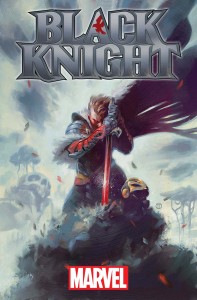 Black Knight #1 — Writer: Frank Tieri; Art: Luca Pizzari; Colors: Antonio Fabela
Black Knight #1 — Writer: Frank Tieri; Art: Luca Pizzari; Colors: Antonio Fabela
Star-Lord #1 — Writer: Sam Humphries; Art: Javier Garron; Colors: Antonio Fabela with Frank D’Armata
Star Wars: Vader Down #1 (of 1) — Writer: Jason Aaron; Art: Mike Deodato; Colors: Frank Martin, Jr.
Secret Wars Too #1 (of 1) — Creators: Various
 The other Marvel first issues for the week: Black Knight has suitably medieval art from Pizzari, and should appeal to Conan fans, although the script from Tieri (our hero is on Weirdworld, a place that Marvel’s really pushing of late, and defending his corner of it from both bad guys and, it turns out at the end, some good ones too), is only so-so. Star-Lord, in its first arc, is eschewing the Guardians of the Galaxy for a Year One origin story — it turns out that Quill wasn’t kidnapped by aliens and taken into space as a child (which I could swear has been
The other Marvel first issues for the week: Black Knight has suitably medieval art from Pizzari, and should appeal to Conan fans, although the script from Tieri (our hero is on Weirdworld, a place that Marvel’s really pushing of late, and defending his corner of it from both bad guys and, it turns out at the end, some good ones too), is only so-so. Star-Lord, in its first arc, is eschewing the Guardians of the Galaxy for a Year One origin story — it turns out that Quill wasn’t kidnapped by aliens and taken into space as a child (which I could swear has been 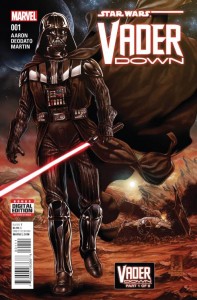 established continuity since forever), but instead stayed on Earth and ended up as a teen also-ran in an astronaut program. Is he tempted to hijack an alien spaceship that NASA is studying and use his simulator-honed pilot chops to get into space? Hey, maybe you can write comic books too…. Vader Down is on similarly-familiar ground: what if, right after the events of Star Wars Episode Four: A New Hope, a solo Vader was forced down on a planet of rebels, where Luke (whom Vader doesn’t know yet is his son) happens to be too. This issue kicks off a six-part crossover between the Darth Vader and Star Wars comics, so fans of either of those books will pretty
established continuity since forever), but instead stayed on Earth and ended up as a teen also-ran in an astronaut program. Is he tempted to hijack an alien spaceship that NASA is studying and use his simulator-honed pilot chops to get into space? Hey, maybe you can write comic books too…. Vader Down is on similarly-familiar ground: what if, right after the events of Star Wars Episode Four: A New Hope, a solo Vader was forced down on a planet of rebels, where Luke (whom Vader doesn’t know yet is his son) happens to be too. This issue kicks off a six-part crossover between the Darth Vader and Star Wars comics, so fans of either of those books will pretty  much have to get it; fortunately, the Aaron/Deodato team makes it a smooth, good-looking piece of space-opera entertainment. Finally, Secret Wars Too is just what its name sounds like: a parody book sending up Marvel’s still-ongoing summer crossover, with a first story by Hickman itself (including a Marvel script conference with seventeen creators sitting around a table: see how many you can name) that makes jokes about the book’s lateness; there’s also a story by Rob Guillory (of Chew fame) and a two-page closer by Eric Powell, of The Goon, plus a couple of other offerings too, more than enough to justify checking it out, even if you aren’t a Secret Wars completist.
much have to get it; fortunately, the Aaron/Deodato team makes it a smooth, good-looking piece of space-opera entertainment. Finally, Secret Wars Too is just what its name sounds like: a parody book sending up Marvel’s still-ongoing summer crossover, with a first story by Hickman itself (including a Marvel script conference with seventeen creators sitting around a table: see how many you can name) that makes jokes about the book’s lateness; there’s also a story by Rob Guillory (of Chew fame) and a two-page closer by Eric Powell, of The Goon, plus a couple of other offerings too, more than enough to justify checking it out, even if you aren’t a Secret Wars completist.
 The Astonishing Ant-Man #2 — Writer: Nick Spencer; Art: Ramon Rosanas; Colors: Jordan Boyd
The Astonishing Ant-Man #2 — Writer: Nick Spencer; Art: Ramon Rosanas; Colors: Jordan Boyd
Captain America #3 — Writer: Nick Spencer; Art/Colors: Daniel Acuna with Mike Choi
The Uncanny Avengers Annual #1 — Writer: James Robinson; Art: Marc Laming with Jose Giles; Colors: Jordan Boyd with Veronica Gandini
The New Avengers #3 — Writer: Al Ewing; Art: Gerardo Sandoval; Colors: Dono Sanchez Almara
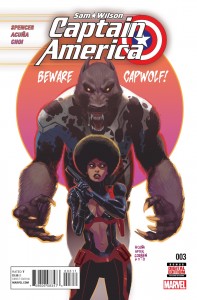 The Uncanny Inhumans #2 — Writer: Charles Soule; Pencils: Steve McNiven; Inks: Jay Leisten; Colors: Sunny Cho
The Uncanny Inhumans #2 — Writer: Charles Soule; Pencils: Steve McNiven; Inks: Jay Leisten; Colors: Sunny Cho
Deadpool #2 — Writer: Gerry Duggan; Pencils: Mike Hawthorne; Inks: Terry Pallot; Colors: Val Staples
Extraordinary X-Men #2 — Writer: Jeff Lemire; Pencils: Humberto Ramos; Inks: Victor Olazaba; Colors: Edgar Delgado
 Some other Marvel books: Ant-Man‘s sophomore issue fills in some backstory on what happened to Scott after the end of the FF series, as his new client happens to be his ex-girlfriend from that book, Darla Deering (and if you’re wondering how the reunion goes, a look at the cover should tell you…); it’s still got a little too much moping by its title character, but that’s leavened by the light tone and some decent action — and a last-page appearance by Sam Wilson/Captain America sets up a logical crossover for next time, since writer Nick
Some other Marvel books: Ant-Man‘s sophomore issue fills in some backstory on what happened to Scott after the end of the FF series, as his new client happens to be his ex-girlfriend from that book, Darla Deering (and if you’re wondering how the reunion goes, a look at the cover should tell you…); it’s still got a little too much moping by its title character, but that’s leavened by the light tone and some decent action — and a last-page appearance by Sam Wilson/Captain America sets up a logical crossover for next time, since writer Nick 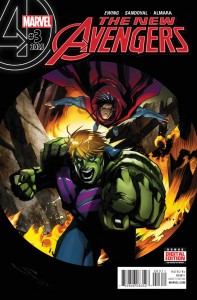 Spencer is scripting both books. His Cap is a little more serious, although that comic’s third issue does offer Sam transformed into the CapWolf mutation from Mark Gruenwald’s ’90s run of the title with Steve Rogers, and a lot of wolf references/puns from an amused Misty Knight — plus artist Acuna doing a cover tribute to the great Richard Corben — so there’s more than enough to keep readers interested. The Avengers books continue their rollouts, too, with Uncanny Avengers offering an annual after just two issues of the regular title.
Spencer is scripting both books. His Cap is a little more serious, although that comic’s third issue does offer Sam transformed into the CapWolf mutation from Mark Gruenwald’s ’90s run of the title with Steve Rogers, and a lot of wolf references/puns from an amused Misty Knight — plus artist Acuna doing a cover tribute to the great Richard Corben — so there’s more than enough to keep readers interested. The Avengers books continue their rollouts, too, with Uncanny Avengers offering an annual after just two issues of the regular title. 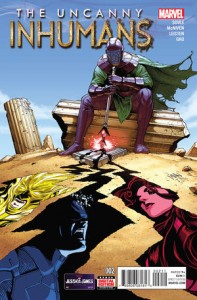 James Robinson’s script involves a late-’40s version of the Avengers, a present-day zombie infestation, and a couple of new/old characters with a few plot twists; let’s just say he’s always been very good at villain origins, going all the way back to The Mist in his Starman comics in the ’90s. New Avengers offers one of those getting-to-know-the-characters issues (a good idea, since except for Hawkeye none of the principles are that familiar) while sowing the seeds for a new arc involving Hulkling and his relationship to the now-shattered Skrull and Kree empires. The art’s kind of dark and
James Robinson’s script involves a late-’40s version of the Avengers, a present-day zombie infestation, and a couple of new/old characters with a few plot twists; let’s just say he’s always been very good at villain origins, going all the way back to The Mist in his Starman comics in the ’90s. New Avengers offers one of those getting-to-know-the-characters issues (a good idea, since except for Hawkeye none of the principles are that familiar) while sowing the seeds for a new arc involving Hulkling and his relationship to the now-shattered Skrull and Kree empires. The art’s kind of dark and 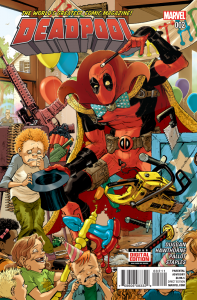 scratchy, and so is the characterization (although there are a couple of good scenes); this book’s going to have to show some zip soon if it doesn’t want to start shedding readers. So too for Uncanny Inhumans, which on its second issue is already bogged down in a time travel/Black Bolt and Medusa’s son plot that’s hard to follow and not terribly interesting. It is fun to have Johnny Storm and the Beast around, and the McNiven art, as always, is detailed and pretty, so there’s still some hope for the title. Deadpool keeps doing what it’s been doing for a couple of years now, with its mix of serious story and nudge-nudge-wink-wink parody;
scratchy, and so is the characterization (although there are a couple of good scenes); this book’s going to have to show some zip soon if it doesn’t want to start shedding readers. So too for Uncanny Inhumans, which on its second issue is already bogged down in a time travel/Black Bolt and Medusa’s son plot that’s hard to follow and not terribly interesting. It is fun to have Johnny Storm and the Beast around, and the McNiven art, as always, is detailed and pretty, so there’s still some hope for the title. Deadpool keeps doing what it’s been doing for a couple of years now, with its mix of serious story and nudge-nudge-wink-wink parody; 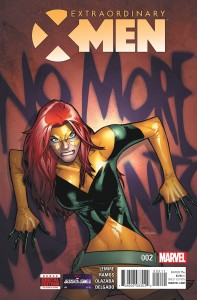 with a bunch of different versions of Wade running around, there’s more than enough lighthearted banter, occasional drama and a couple of plot twists to entertain fans. Extraordinary X-Men is in team-building mode, with Storm enlisting Iceman and Magik to help in recruiting the younger Jean Grey and Nightcrawler; once the Old Man Logan version of Wolverine shows up, the actual plot can commence. It’s all a little slow-going, but sets up events that promise quite a bit of action next issue, and if you’re a fan of Ramos’s cartoony art, like I am, watching him illustrate the various heroes, Sentinels, villains and demons is more than enough incentive to keep reading.
with a bunch of different versions of Wade running around, there’s more than enough lighthearted banter, occasional drama and a couple of plot twists to entertain fans. Extraordinary X-Men is in team-building mode, with Storm enlisting Iceman and Magik to help in recruiting the younger Jean Grey and Nightcrawler; once the Old Man Logan version of Wolverine shows up, the actual plot can commence. It’s all a little slow-going, but sets up events that promise quite a bit of action next issue, and if you’re a fan of Ramos’s cartoony art, like I am, watching him illustrate the various heroes, Sentinels, villains and demons is more than enough incentive to keep reading.
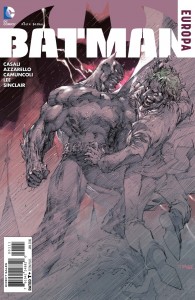 Batman: Europa #1 (of 4) — Story: Matteo Casali and Brian Azzarello; Layouts: Giuseppe Camuncoli; Pencils and Finishes: Jim Lee; Colors: Alex Sinclair
Batman: Europa #1 (of 4) — Story: Matteo Casali and Brian Azzarello; Layouts: Giuseppe Camuncoli; Pencils and Finishes: Jim Lee; Colors: Alex Sinclair
Bizarro #6 — Writer: Heath Corson; Art: Gustavo Duarte; Colors: Pete Pantazis
Martian Manhunter #6 — Writer: Rob Williams; Pencils: Eddy Barrows; Inks: Eber Ferreira; Colors: Gabe Eltaeb
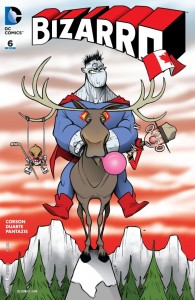 Some DCs of note: Batman: Europa is the first of a four-part mini-series involving Batman infected with a deadly virus and racing around the world to figure out how not to die from it; he teams up with the Joker, and it’s pencilled and finished by Jim Lee, so it’s very hard to pass up. Bizarro has been, against all odds, the best of the new DC books: an offbeat buddy-comedy mini-series with the title character and Jimmy Olson looking for America (or, rather, Canada, it am being the Bizarro version of America), with zany humor, a
Some DCs of note: Batman: Europa is the first of a four-part mini-series involving Batman infected with a deadly virus and racing around the world to figure out how not to die from it; he teams up with the Joker, and it’s pencilled and finished by Jim Lee, so it’s very hard to pass up. Bizarro has been, against all odds, the best of the new DC books: an offbeat buddy-comedy mini-series with the title character and Jimmy Olson looking for America (or, rather, Canada, it am being the Bizarro version of America), with zany humor, a 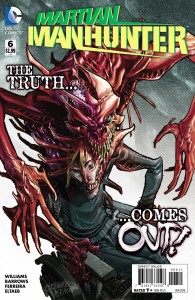 couple of actual themes, and razor-sharp art/coloring from Duarte and Pantazis; in this final issue, they stick the landing, and if you’ve been holding off on it this is a good time to get the whole six-issue run. Martian Manhunter, also on its sixth issue, has also been good, and getting better with each issue: Barrows is as good at fusing superheroes and horror as a Tom Mandrake or Gene Colan, and Williams, in his first sustained shot at a mainstream superhero book, is making a memorable impression, with a sophisticated high-stakes script, memorable characters and unexpected swerves.
couple of actual themes, and razor-sharp art/coloring from Duarte and Pantazis; in this final issue, they stick the landing, and if you’ve been holding off on it this is a good time to get the whole six-issue run. Martian Manhunter, also on its sixth issue, has also been good, and getting better with each issue: Barrows is as good at fusing superheroes and horror as a Tom Mandrake or Gene Colan, and Williams, in his first sustained shot at a mainstream superhero book, is making a memorable impression, with a sophisticated high-stakes script, memorable characters and unexpected swerves.
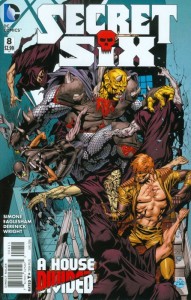 Secret Six #8 — Writer: Gail Simone; Art: Dale Eaglesham and Tom Derenick; Colors: Jason Wright
Secret Six #8 — Writer: Gail Simone; Art: Dale Eaglesham and Tom Derenick; Colors: Jason Wright
Clean Room #2 — Writer: Gail Simone; Art/Colors: Jon Davis-Hunt
Red Thorn #1 — Writer: David Baillie; Art: Meghan Hetrick; Colors: Steve Oliff
Simone’s Secret Six has been around in various incarnations for a number of years now, and is a dependably-good blend of B-list villains — some psychotic, some fiercely independent and others just 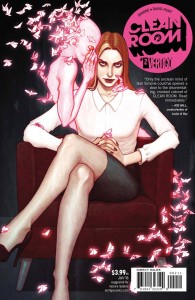 misunderstood — who form a dysfunctional family; this version really hooked me a few issues ago when it turned out that Big Shot, who dresses like a ’40s movie detective and can get, well, bigger, is actually Ralph Dibney, the Elongated Man, and it hasn’t let up on its dark sense of fun and action since. Clean Room is Simone’s Vertigo book, about a woman who’s a cult leader, the reporter who confronts her, and a bunch of psychological/occult horror elements that it presents through smoothly-staged scenes punctuated with effective jolts. Red Thorn is about an American
misunderstood — who form a dysfunctional family; this version really hooked me a few issues ago when it turned out that Big Shot, who dresses like a ’40s movie detective and can get, well, bigger, is actually Ralph Dibney, the Elongated Man, and it hasn’t let up on its dark sense of fun and action since. Clean Room is Simone’s Vertigo book, about a woman who’s a cult leader, the reporter who confronts her, and a bunch of psychological/occult horror elements that it presents through smoothly-staged scenes punctuated with effective jolts. Red Thorn is about an American 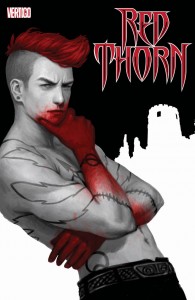 woman in Glascow investigating the death of her sister, many years before; it’s casually mentioned that the woman’s an artist whose human portraits can come to life (like, you know, no big deal; everyone’s got talents), and there are supernatural Scottish spirits involved. Peter Gross and Mike Carey are name-checked for “special thanks” in the credits, and this is exactly the kind of story they’d have come up with in the ’90s as a Books of Magic or Lucifer spinoff. My only quarrel with the book’s the cover, which seems to be ripping off a Joel McHale Soup promo poster….
woman in Glascow investigating the death of her sister, many years before; it’s casually mentioned that the woman’s an artist whose human portraits can come to life (like, you know, no big deal; everyone’s got talents), and there are supernatural Scottish spirits involved. Peter Gross and Mike Carey are name-checked for “special thanks” in the credits, and this is exactly the kind of story they’d have come up with in the ’90s as a Books of Magic or Lucifer spinoff. My only quarrel with the book’s the cover, which seems to be ripping off a Joel McHale Soup promo poster….
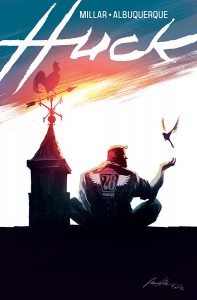 Huck #1 — Writer: Mark Millar; Art: Rafael Albuquerque; Colors: Dave McCaig
Huck #1 — Writer: Mark Millar; Art: Rafael Albuquerque; Colors: Dave McCaig
Pretty Deadly #6 — Writer: Kelly Sue DeConnick; Art: Emma Rios; Colors: Jordie Bellaire
Phonogram: The Immaterial Girl #4 (of 6) — Writer: Kieron Gillen; Art: Jamie McKelvie; Colors: Matthew Wilson
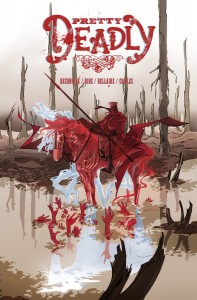 I Hate Fairyland #2 — Writer/Artist: Skottie Young; Colors: Jean Francois Beaulieu
I Hate Fairyland #2 — Writer/Artist: Skottie Young; Colors: Jean Francois Beaulieu
A quartet of indy books still early in their runs; the only first issue, Huck, is a Mark Millar riff on “What if Clark Kent had remained a simple country lad?”,  and is helped along by the painterly Albuquerque art. Pretty Deadly, after a long hiatus, returns with the first chapter of a new arc, now set during WW I, and is just as stubbornly subtle and beautiful as ever, while Phonogram is a thoroughly-modern music-as-magic story that benefits from Gillen and McKelvie’s long history with and affection for the characters (it helps if you’ve read the first two
and is helped along by the painterly Albuquerque art. Pretty Deadly, after a long hiatus, returns with the first chapter of a new arc, now set during WW I, and is just as stubbornly subtle and beautiful as ever, while Phonogram is a thoroughly-modern music-as-magic story that benefits from Gillen and McKelvie’s long history with and affection for the characters (it helps if you’ve read the first two 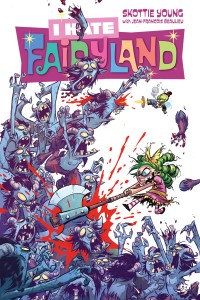 volumes and know them, too), easy experimental rapport (they, and Matthew Wilson, do some cool things with color in this issue), and encyclopedic knowledge of British pop-music history. I Hate Fairyland is Skottie Young’s Alice-gone-wrong comic about a child stuck on a fairy quest in a Wonderland-like dimension for decades, until, still trapped in her eight-year-old body but mentally in her thirties, she’s now willing to murder anyone who gets in her way; that makes it sound grim, but it’s more like an early-Mad take-no-prisoners slapstick romp, and a massive guilty pleasure.
volumes and know them, too), easy experimental rapport (they, and Matthew Wilson, do some cool things with color in this issue), and encyclopedic knowledge of British pop-music history. I Hate Fairyland is Skottie Young’s Alice-gone-wrong comic about a child stuck on a fairy quest in a Wonderland-like dimension for decades, until, still trapped in her eight-year-old body but mentally in her thirties, she’s now willing to murder anyone who gets in her way; that makes it sound grim, but it’s more like an early-Mad take-no-prisoners slapstick romp, and a massive guilty pleasure.
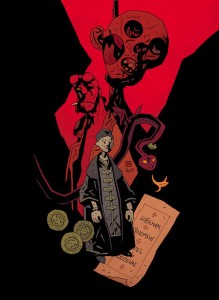 Dark Horse Presents #16 — Creators: Various
Dark Horse Presents #16 — Creators: Various
Astro City #29 — Writer: Kurt Busiek; Art: Brent Anderson; Colors: Peter Pantazis
Rachel Rising #37 — Creator: Terry Moore
Lumberjanes #20 — Writers: Shannon Watters and Kat Leyh; Art: Carolyn Nowak; Colors:  Maarta Laiho
Maarta Laiho
Usagi Yojimbo #150 — Creator: Stan Sakai
The more-established, dependably-good indy books. Dark Horse Presents always rises or falls on its anthology elements, but this issue has a Mike Mignola-drawn Hellboy story set in current 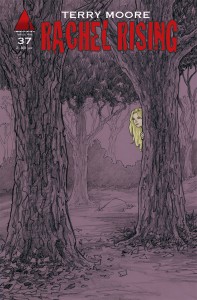 continuity (i.e., he’s in hell), complete with a Mignola back cover, so buying it’s a no-brainer; it’s also got a Brandon McCarthy Dream Gang story, and works by David Chelsea, Carla Speed McNeil and Alex de Campi/Jerry Ordway, so there’s plenty to recommend it. Astro City, behind its Alex Ross cover, has Busiek and Anderson offering the first chapter of a tale about aliens kidnapping a member of a superhero team and the team getting
continuity (i.e., he’s in hell), complete with a Mignola back cover, so buying it’s a no-brainer; it’s also got a Brandon McCarthy Dream Gang story, and works by David Chelsea, Carla Speed McNeil and Alex de Campi/Jerry Ordway, so there’s plenty to recommend it. Astro City, behind its Alex Ross cover, has Busiek and Anderson offering the first chapter of a tale about aliens kidnapping a member of a superhero team and the team getting 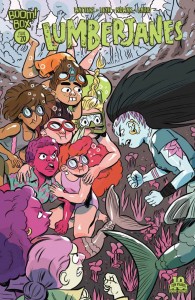 them back (think that FF story where the Thing gets kidnapped by Skrulls who’ve seen too many gangster movies), except that it’s totally from the perspective of a middle-class family on the alien planet: a good example of the way this book upends cliches and stays smart and fresh. Rachel Rising continues its occult/horror story with a breather issue that advances the plot through a clever narrative/art parallel construction, and still manages its requisite
them back (think that FF story where the Thing gets kidnapped by Skrulls who’ve seen too many gangster movies), except that it’s totally from the perspective of a middle-class family on the alien planet: a good example of the way this book upends cliches and stays smart and fresh. Rachel Rising continues its occult/horror story with a breather issue that advances the plot through a clever narrative/art parallel construction, and still manages its requisite 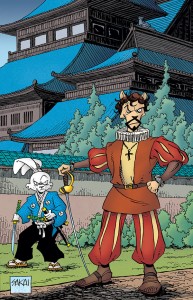 two scenes of people (or, in one case, a dog) committing terrible acts, those moments that horror fans live for. Lumberjanes continues its mer-people-in-the-lake story, while Usagi Yojimbo offers a stand-alone tale about a Shakespearean-era Spanish swordsman in Japan who pays the ultimate price for his cruel curiosity and arrogance; both are too-little-appreciated comics because they offer top-tier stories in unusual genres, and, if you have an extra few bucks this week, are well worth taking a chance on.
two scenes of people (or, in one case, a dog) committing terrible acts, those moments that horror fans live for. Lumberjanes continues its mer-people-in-the-lake story, while Usagi Yojimbo offers a stand-alone tale about a Shakespearean-era Spanish swordsman in Japan who pays the ultimate price for his cruel curiosity and arrogance; both are too-little-appreciated comics because they offer top-tier stories in unusual genres, and, if you have an extra few bucks this week, are well worth taking a chance on.



